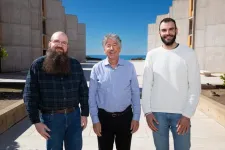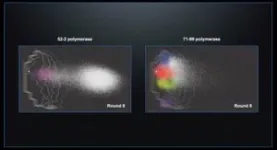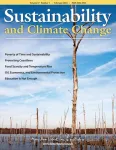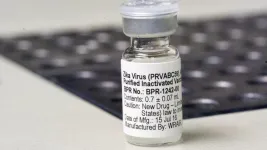(Press-News.org) LA JOLLA (March 4, 2024)—Charles Darwin described evolution as "descent with modification." Genetic information in the form of DNA sequences is copied and passed down from one generation to the next. But this process must also be somewhat flexible, allowing slight variations of genes to arise over time and introduce new traits into the population.
But how did all of this begin? In the origins of life, long before cells and proteins and DNA, could a similar sort of evolution have taken place on a simpler scale? Scientists in the 1960s, including Salk Fellow Leslie Orgel, proposed that life began with the “RNA World,” a hypothetical era in which small, stringy RNA molecules ruled the early Earth and established the dynamics of Darwinian evolution.
New research at the Salk Institute now provides fresh insights on the origins of life, presenting compelling evidence supporting the RNA World hypothesis. The study, published in Proceedings of the National Academy of Sciences (PNAS) on March 4, 2024, unveils an RNA enzyme that can make accurate copies of other functional RNA strands, while also allowing new variants of the molecule to emerge over time. These remarkable capabilities suggest the earliest forms of evolution may have occurred on a molecular scale in RNA.
The findings also bring scientists one step closer to re-creating RNA-based life in the laboratory. By modeling these primitive environments in the lab, scientists can directly test hypotheses about how life may have started on Earth, or even other planets.
"We're chasing the dawn of evolution,” says senior author and Salk President Gerald Joyce. "By revealing these novel capabilities of RNA, we're uncovering the potential origins of life itself, and how simple molecules could have paved the way for the complexity and diversity of life we see today."
Scientists can use DNA to trace the history of evolution from modern plants and animals all the way back to the earliest single-celled organisms. But what came before that remains unclear. Double-stranded DNA helices are great for storing genetic information. Many of those genes ultimately code for proteins—complex molecular machines that carry out all sorts of functions to keep cells alive. What makes RNA unique is that these molecules can do a bit of both. They’re made of extended nucleotide sequences, similar to DNA, but they can also act as enzymes to facilitate reactions, much like proteins. So, is it possible that RNA served as the precursor to life as we know it?
Scientists like Joyce have been exploring this idea for years, with a particular focus on RNA polymerase ribozymes—RNA molecules that can make copies of other RNA strands. Over the last decade, Joyce and his team have been developing RNA polymerase ribozymes in the lab, using a form of directed evolution to produce new versions capable of replicating larger molecules. But most have come with a fatal flaw: they aren’t able to copy the sequences with a high enough accuracy. Over many generations, so many errors are introduced into the sequence that the resulting RNA strands no longer resemble the original sequence and have lost their function entirely.
Until now. The latest RNA polymerase ribozyme developed in the lab includes a number of crucial mutations that allow it to copy a strand of RNA with much higher accuracy.
In these experiments, the RNA strand being copied is a “hammerhead,” a small molecule that cleaves other RNA molecules into pieces. The researchers were surprised to find that not only did the RNA polymerase ribozyme accurately replicate functional hammerheads, but over time, new variations of the hammerheads began to emerge. These new variants performed similarly, but their mutations made them easier to replicate, which increased their evolutionary fitness and led them to eventually dominate the lab’s hammerhead population.
“We’ve long wondered how simple life was at its beginning and when it gained the ability to start improving itself,” says first author Nikolaos Papastavrou, a research associate in Joyce’s lab. “This study suggests the dawn of evolution could have been very early and very simple. Something at the level of individual molecules could sustain Darwinian evolution, and that might have been the spark that allowed life to become more complex, going from molecules to cells to multicellular organisms.”
The findings highlight the critical importance of replication fidelity in making evolution possible. The RNA polymerase’s copying accuracy must exceed a critical threshold to maintain heritable information over multiple generations, and this threshold would have risen as the evolving RNAs increased in size and complexity.
Joyce’s team is re-creating this process in laboratory test tubes, applying increasing selective pressure on the system to produce better-performing polymerases, with the goal of one day producing an RNA polymerase that can replicate itself. This would mark the beginnings of autonomous RNA life in the laboratory, which the researchers say could be accomplished within the next decade.
The scientists are also interested in what else might occur once this mini “RNA World” has gained more autonomy.
“We’ve seen that selection pressure can improve RNAs with an existing function, but if we let the system evolve for longer with larger populations of RNA molecules, can new functions be invented?” says co-author David Horning, a staff scientist in Joyce’s lab. “We’re excited to answer how early life could ratchet up its own complexity, using the tools developed here at Salk.”
The methods used in the Joyce lab also pave the way for future experiments testing other ideas about the origins of life, including what environmental conditions could have best supported RNA evolution, both on Earth and on other planets.
The work was supported by NASA (80NSSC22K0973) and the Simons Foundation (287624).
About the Salk Institute for Biological Studies:
Unlocking the secrets of life itself is the driving force behind the Salk Institute. Our team of world-class, award-winning scientists pushes the boundaries of knowledge in areas such as neuroscience, cancer research, aging, immunobiology, plant biology, computational biology, and more. Founded by Jonas Salk, developer of the first safe and effective polio vaccine, the Institute is an independent, nonprofit research organization and architectural landmark: small by choice, intimate by nature, and fearless in the face of any challenge. Learn more at www.salk.edu.
END
Modeling the origins of life: New evidence for an “RNA World”
Salk scientists unveil RNA capabilities that enable Darwinian evolution at a molecular scale, and bring researchers closer to producing autonomous RNA life in the laboratory
2024-03-04
ELSE PRESS RELEASES FROM THIS DATE:
Scientists put forth a smarter way to protect a smarter grid
2024-03-04
RICHLAND, Wash.—There’s a down side to “smart” devices: They can be hacked.
That makes the electric grid, increasingly chock full of devices that interact with one another and make critical decisions, vulnerable to bad actors who might try to turn off the power, damage the system or worse.
But smart devices are a big part of our future as the world moves more toward renewable energy and the many new devices to manage it. Already, such tools play a big role in keeping the power humming. The portion of the grid owned by ...
An evolutionary mystery 125 million years in the making
2024-03-04
Plant genomics has come a long way since Cold Spring Harbor Laboratory (CSHL) helped sequence the first plant genome. But engineering the perfect crop is still, in many ways, a game of chance. Making the same DNA mutation in two different plants doesn’t always give us the crop traits we want. The question is why not? CSHL plant biologists just dug up a reason.
CSHL Professor and HHMI Investigator Zachary Lippman and his team discovered that tomato and Arabidopsis thaliana plants can use very different regulatory systems to control the same exact ...
Data science approach to identifying thermal conductivity-related structural factors in amorphous materials
2024-03-04
1. Using data science techniques, a NIMS–Tohoku University research team has discovered that different thermal conductivities exhibited by an amorphous material with the same composition are attributable to the sizes of atomic rings in its atomic structure. This is one of the first studies demonstrating that the structural features of amorphous materials can be correlated with their physical properties.
2. It is already feasible to synthesize amorphous materials with the same compositions but different thermal conductivities. However, the structural factors responsible for differences in thermal conductivity had yet to be identified due to a lack of appropriate analytical ...
Deciphering the male breast cancer genome
2024-03-04
Male breast cancer has distinct alterations in the tumor genome that may suggest potential treatment targets, according to a study by Weill Cornell Medicine investigators. They have conducted the first whole genome sequencing analysis of male breast cancer, which looked at the complete DNA landscape of tumor samples from 10 patients.
This is an important step in viewing breast cancer in men, which represents less than 1 percent of all breast cancer cases each year, as a unique disease. Though most research has focused on women with breast cancer, the incidence in men has increased at a much faster rate than in women over the last 40 years. Also, ...
Detection of suicide-related emergencies among children using real-world clinical data: A free webinar from the Brain & Behavior Research Foundation
2024-03-04
According to the CDC, the suicide rate among young people ages 10‒24 increased 62% from 2007 through 2021. The CDC’s Youth Risk Behavior Summary reports that in 2021, 22% of high school students seriously considered attempting suicide during the year and 18% made a suicide plan. These statistics indicate a mental health crisis facing our youth. How can we identify children in crisis? Who is being missed?
The Brain & Behavior Research Foundation (BBRF) is hosting a free webinar, “Detection of Suicide-Related Emergencies Among ...
Editor-in-Chief of Sustainability and Climate Change Madhavi Venkatesan named USA TODAY Woman of the Year for Massachusetts for leading plastic bottle ban efforts
2024-03-04
Madhavi Venkatesan, PhD, Editor-in-Chief of the peer-reviewed journal Sustainability and Climate Change and founder of Sustainable Practices, has been named USA TODAY Woman of the Year for the state of Massachusetts in recognition of her outstanding efforts to eliminate single-use plastic bottles across Cape Cod and the Islands.
With economics and sustainability at the forefront, Venkatesan established Sustainable Practices in 2016, aiming to address pressing environmental issues through innovative solutions. Since then, she and her nonprofit team have spearheaded ...
Tests show high-temperature superconducting magnets are ready for fusion
2024-03-04
In the predawn hours of Sept. 5, 2021, engineers achieved a major milestone in the labs of MIT’s Plasma Science and Fusion Center (PSFC), when a new type of magnet, made from high-temperature superconducting material, achieved a world-record magnetic field strength of 20 tesla for a large-scale magnet. That’s the intensity needed to build a fusion power plant that is expected to produce a net output of power and potentially usher in an era of virtually limitless power production.
The test was immediately declared ...
Zika vaccine safe, effective when administered during pregnancy
2024-03-04
A vaccine against Zika virus is safe and effective when administered both before and during pregnancy, according to new research published in npj Vaccines.
The purified, inactivated Zika vaccine (ZPIV) candidate, developed by Walter Reed Army Institute of Research (WRAIR), is being evaluated in animal models at Texas Biomedical Research Institute (Texas Biomed) in collaboration with WRAIR and Trudeau Institute in New York.
The vaccine candidate has previously been shown to effectively block prenatal Zika virus transmission when given to nonhuman primates ...
Firearm ownership is correlated with elevated lead levels in children, study finds
2024-03-04
PROVIDENCE, R.I. [Brown University] — Childhood lead exposure, primarily from paint and water, is a significant health concern in the United States, but a new study has identified a surprising additional source of lead exposure that may disproportionately harm children: firearms.
A team led by researchers at Brown University found an association between household firearm ownership and elevated lead levels in children’s blood in 44 states, even when controlling for other major lead exposure ...
Role of African women and young people in agricultural service provision investigated in new CABI-led study
2024-03-04
The role of African women and young people engaged in agricultural service provision has been investigated in a new CABI-led study published in the CABI Agriculture and Bioscience journal.
By combining a literature review with ongoing action research in Kenya, the scientists provide insights into the main characteristics, benefits, and shortfalls of business models for engaging women and young people in agricultural service provision in Africa.
‘Not a panacea to the challenges faced’
The findings show that the engagement of African women and young people in agricultural service provision is ‘not a panacea to the challenges they face’ such as limited ...
LAST 30 PRESS RELEASES:
When is it time to jump? The boiling frog problem of AI use in physics education
Twitter data reveals partisan divide in understanding why pollen season's getting worse
AI is quick but risky for updating old software
Revolutionizing biosecurity: new multi-omics framework to transform invasive species management
From ancient herb to modern medicine: new review unveils the multi-targeted healing potential of Borago officinalis
Building a global scientific community: Biological Diversity Journal announces dual recruitment of Editorial Board and Youth Editorial Board members
Microbes that break down antibiotics help protect ecosystems under drug pollution
Smart biochar that remembers pollutants offers a new way to clean water and recycle biomass
Rice genes matter more than domestication in shaping plant microbiomes
Ticking time bomb: Some farmers report as many as 70 tick encounters over a 6-month period
Turning garden and crop waste into plastics
Scientists discover ‘platypus galaxies’ in the early universe
Seeing thyroid cancer in a new light: when AI meets label-free imaging in the operating room
Neutrophil-to-lymphocyte ratio may aid risk stratification in depressive disorder
2026 Seismological Society of America Annual Meeting
AI-powered ECG analysis offers promising path for early detection of chronic obstructive pulmonary disease, says Mount Sinai researchers
GIMM uncovers flaws in lab-grown heart cells and paves the way for improved treatments
Cracking the evolutionary code of sleep
Medications could help the aging brain cope with surgery, memory impairment
Back pain linked to worse sleep years later in men over 65, according to study
CDC urges ‘shared decision-making’ on some childhood vaccines; many unclear about what that means
New research finds that an ‘equal treatment’ approach to economic opportunity advertising can backfire
Researchers create shape-shifting, self-navigating microparticles
Science army mobilizes to map US soil microbiome
Researchers develop new tools to turn grain crops into biosensors
Do supervised consumption sites bring increased crime? Study suggests that’s a myth
New mass spec innovation could transform research
Maternal nativity, race, and ethnicity and infant mortality in the US
Migration-related trauma among asylum seekers exposed to the migrant protection protocols
Jupiter’s moon Europa has a seafloor that may be quiet and lifeless
[Press-News.org] Modeling the origins of life: New evidence for an “RNA World”Salk scientists unveil RNA capabilities that enable Darwinian evolution at a molecular scale, and bring researchers closer to producing autonomous RNA life in the laboratory









